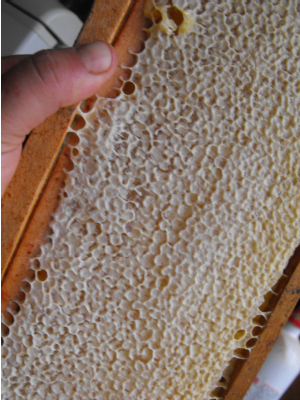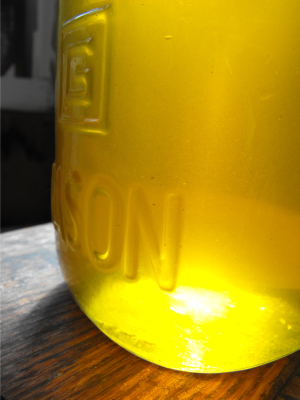
Routed by the bees
 I've
been known to tell prospective apiarists that bee stings don't
hurt. "It's about like getting a shot," I tell them. "You
feel it for a minute, but pretty soon you've forgotten it even
happened." Friday, I learned that I was lying.
I've
been known to tell prospective apiarists that bee stings don't
hurt. "It's about like getting a shot," I tell them. "You
feel it for a minute, but pretty soon you've forgotten it even
happened." Friday, I learned that I was lying.
I've been going into the
hives every week lately, trying to keep the brood boxes open while the
bees try to fill them with honey in preparation for an eventual swarm
that I'm determined won't happen. Last week, I added a second
brood box on one of the hives, checkerboarding empty frames and full
frames so that the hive now had two half empty brood boxes rather than
one mostly full one. I wanted to see how that experiment was
working out, but when I opened the hive all I saw was honey.
We've barely had any
rain in the last few weeks, so I shouldn't have been too surprised to
see that two supers were chock full of mostly or completely capped
honey. I carefully removed two frames for extraction, and paged
through the other frames to make sure the queen hadn't moved up to lay
in the supers. So far so good --- all twenty frames were brood
free. But there was just so much honey that I accidentally nicked
a couple of frames, and sweet, gooey honey dripped down through the
hive.
Maybe the open honey got
the bees' dander up, or more likely the bees sensed the first few
clouds converging and the dropping barometric pressure that forecast a
storm moving into our neighborhood. All I know is that halfway
through my inspection of the top brood box, a bee stung me on the
arm. Whatever --- no big deal. But I know that when one bee
stings, the other bees can smell it and I should close up the
hive. Unfortunately, a sting also jars me out of my "bee zone"
--- a zen-like state where I move slowly and the bees barely know I'm
there. I started to close the hive too quickly and the second
sting came, then the third.
Those of you who've been
following along at home have probably noticed that I wear a pretty
tight shirt when checking on the hive. It shouldn't be that tight
since having cloth appressed to skin makes it easy for a bee to sting
through, but it's the only light-weight, non-button-up, long-sleeved
shirt I own (a wardrobe choice that is soon to be remedied.)
Anyway, the bees were mad, and they made straight for the big things
bulging out at them, which unfortunately happened to be a very
sensitive portion of my anatomy. Ten stings later, the hive was
closed, and I was nearly in tears.
 Once
I calmed back down and did a bit of research, I discovered that --- as
usual when I get stung --- I was doing several things wrong. As
soon as I noticed the first clouds gathering, I should have packed
everything up and gone home. Secondly, I should have stuck to
either checking on the brood box or robbing honey, not both.
Finally, when I did get stung, I should have immediately left the hive, puffed a little
smoke on the wound, and given both the bees and myself a couple of
minutes to calm down. I suspect if I'd taken that first sting as
a warning, brought myself back to the bee zone, and closed up the hive
slowly, all would have been well. I certainly don't want to leave
any potential beekeepers thinking that the hive is a dangerous place,
but it is quite easy to get stupid, especially as a newbie.
Once
I calmed back down and did a bit of research, I discovered that --- as
usual when I get stung --- I was doing several things wrong. As
soon as I noticed the first clouds gathering, I should have packed
everything up and gone home. Secondly, I should have stuck to
either checking on the brood box or robbing honey, not both.
Finally, when I did get stung, I should have immediately left the hive, puffed a little
smoke on the wound, and given both the bees and myself a couple of
minutes to calm down. I suspect if I'd taken that first sting as
a warning, brought myself back to the bee zone, and closed up the hive
slowly, all would have been well. I certainly don't want to leave
any potential beekeepers thinking that the hive is a dangerous place,
but it is quite easy to get stupid, especially as a newbie.
One final note: Although
the bees clearly won that round, as you'll see in my next post, the
ending was sweet....
Want more in-depth information? Browse through our books.
Or explore more posts by date or by subject.
About us: Anna Hess and Mark Hamilton spent over a decade living self-sufficiently in the mountains of Virginia before moving north to start over from scratch in the foothills of Ohio. They've experimented with permaculture, no-till gardening, trailersteading, home-based microbusinesses and much more, writing about their adventures in both blogs and books.
Want to be notified when new comments are posted on this page? Click on the RSS button after you add a comment to subscribe to the comment feed, or simply check the box beside "email replies to me" while writing your comment.

To sign in with your name, click on the option for "other" at the end of the list of choices. I know it's a bit confusing --- my brother's getting ready to roll out the software I'm using for use by the general public, and he's making a lot of changes to test them out on us.
I agree that bumblebees are much more painful than honeybees! Luckily, my stings stopped hurting pretty quickly, though I was a bit sore the next day. I think I was mostly just shocked that my sweet little bees had been so angry.
Get a secondhand denim jacket, have Mark cut an old oil drum into pieces, get a bucketload of rivets, and make yourself a brigandine. Ok, it's a bit of work, but no bee is going to sting through that!
The version with plates on the outside is the much earlier scale armor or lorica squamata.
The brigandine looked a lot like the contemporary civilian doublet while still providing good protection and freedom of movement, and being much lighter and cheaper than plate armor. With the cloth on the outside it was easily decorated, and possibly less vulnerable to an up thrusting sword or dagger. It was commonly worn over a padded jacket, to cushion impacts.
On second thought, using metal plates is probably overdoing it. (unless you're also expecting zombies. )
)
Maybe even pieces of a plastic milk jug would suffice instead.
Alternatively, you can get woven steel mesh with up to 600 threads/inch, which is still quite light. Can't imagine a bee stinging through that!